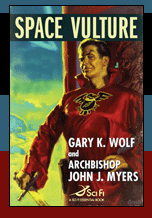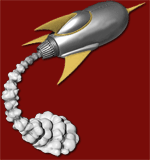 |

|
|||||
Stellar Operations If you know Star Wars, you know space opera. George Lucas's blockbuster franchise is indisputably a space opera, the most famous of all time. Star Trek, of course, held that distinction up until 1977, and between exposure to those two properties the general public has absorbed a limited but fairly detailed sense of that "widescreen baroque" mode of science fiction. Earlier generations, of course, would have simply pointed to Flash Gordon and Buck Rogers. Coined by author Wilson Tucker in 1941 on analogy with "soap opera" and "horse opera," the term originally carried pejorative connotations, before undergoing a gradual positive shift to its current meaning: in the words of The Encyclopedia of Science Fiction, space opera is "colorful action-adventure stories of interplanetary or interstellar conflict." But that's hardly the whole picture In 2006, David Hartwell and Kathryn Cramer -- a husband-and-wife team who are simultaneously editors, critics, historians, scholars and fans -- published The Space Opera Renaissance. It took them nearly 1,000 pages to limn the subgenre, by fictional exemplars and cogent essays. Surprisingly, they deduced that space opera, at least the written kind, now ranks as one of the most literary and postmodern types of SF. In support of this thesis, a year later came The New Space Opera, original stories compiled by Gardner Dozois and Jonathan Strahan. To fully understand all the dimensions, past and current, of this narrative school, you could not do better than to peruse these two volumes. In support of that, I'll just wait here for a week or so. All done? Fine! With your new comprehension of space opera, let's examine four novels, two old, two new. Inconveniently limiting our survey, all four embrace the old-fashioned space opera paradigm, not the postmodern one. But they all offer varying degrees of pleasure. In the 1930s two pulp writers, Harry Bates and Desmond Hall, created the character of Hawk Carse, a.k.a. Space Hawk. His adventures were collected in book form in 1952. Upon publication, this volume was eagerly assimilated by two youths: Gary K. Wolf and John J. Myers. The former grew up to become the bestselling author of Who Censored Roger Rabbit? (1981), while the latter is currently the Catholic archbishop of Newark! Together, they have written an homage to their childhood idol. Their novel Space Vulture seeks to recapture a certain pulp giddiness, where action, heroism, villainy and improbable super-science outweigh subtlety and emotional insights. In this goal they have for the most part succeeded beyond common aspirations. Tossing maturity, logic, and fine writing to the wind, they manage to escape self-consciousness and create a pastiche on the order of William Goldman's The Princess Bride (1973) or Brad Bird's The Incredibles (2004). Interstellar pirate Space Vulture is an egotistical superman who favors the same high-collared wardrobe as Ming the Merciless. His equally adroit nemesis, Galactic Marshal Captain Victor Corsaire, is less gaudy but still fully capable of MacGyvering his way out of any "escape-proof" cell. Across a galaxy stuffed with a million odd species of aliens -- and some sympathetic supporting human characters -- the duo battle for supremacy in nonstop fashion. Not even impalement with a tree-trunk stops the Vulture, nor does loss of an arm deter Corsaire. If you can accept such blatant assaults on realism, you'll find Space Vulture as nostalgically rich as a five-cent Hershey bar. By the '40s, Isaac Asimov was contouring space opera in the pages of Astounding magazine into its mature form with his Foundation stories. But when the time came for his first hardcover novel in 1950, Pebble in the Sky, a prequel to the Foundation stories, he must have been feeling wistfully revisionist toward his own creation. How else to explain a book where the "hero" is a flabby 62-year-old milquetoast from our era catapulted across the millennia to a ruined radioactive Earth where galactic overlords enforce mandatory euthanasia when citizens turn 60? Confined solely to a cloistered and gloomy terrestrial milieu, despite background allusions to "the hundred million star systems that composed the all-embracing Galactic Empire," this novel lacks all the brio and glitter of traditional space opera and instead deals mostly with the issue of bigotry. Plainly, Asimov was moved by the nascent civil rights movement, and his earnest allegory of Earthman-as-Negro will strike the 21st-century reader as somewhat labored and obvious. But even this high-minded theme does not preclude outcroppings of super-science-mind control powers like Obi Wan Kenobi's, developed through the "Synapsifier," that will tease if not sate the ever-hungry sense of wonder. The "New Wave" movement in science fiction, which sought to introduce higher literary standards, realism, and increased political and cultural relevance to the genre, was well underway by 1966, and consequently the opposing mode of space opera was arguably at its nadir. Yet a few authors, such as Larry Niven and Keith Laumer, persisted in turning out such sagas -- with all due refinements, such as de-privileging the role of our species -- thus paving the way for the ultimate '60s space opera, Samuel Delany's Nova (1968). Laumer's Earthblood, coauthored with Rosel George Brown, stands in my estimation as the pinnacle of that decade's space opera prior to Delany's reimagining of the form. So far as he knows, the young man named Roan is the last human -- or "Terry" -- in a galaxy of uncaring, hostile aliens. How far we've come from Asimov's human-only polity! Earthblood is a merciless, unsentimental Bildungsroman charting Roan's maturation and search for the legendary planet of Terra that birthed his once-regnant species. Consumed with 30,000-year-old dreams of past glories, Roan bulls his way past a thousand exotic obstacles until he finds the lost planet -- and encounters the true decadence of his kind. Laumer was a master of tough-guy, noir posturing and slam-bang action, and these traits are not missing from Earthblood. But this novel is also infused with genuine tenderness, emotional intimacy between Roan and his pals, and a kind of wabi-sabi sense of mortality and transience. The new omnibus edition features individual stories from Laumer and Brown, and so you can gauge which writer contributed what to the brilliant fusion that is Earthblood. Asimov once joked about his Foundation future history that it was merely Gibbon's History of the Decline and Fall of the Roman Empire writ large. The Ruby Dice, the latest entry in Catherine Asaro's long-running Skolian Empire series, might similarly be a Robert Graves historical novel transposed to a galactic milieu. Eschewing space opera's glorious potential for widescreen baroque and instead substituting rather claustrophobic palace conspiracies, Asaro details how the leaders of two rival confederations -- the Eubian Concord and the Skolian Imperialate -- must survive both internal dissension and enemy attacks (not to mention the actual potential dissolution of the space-time continuum) to broker a peace treaty between their peoples Neither man revels much in his power. Jaibriol of the Eubians is hiding a tainted ancestry, while Kelric of the Skolians has had to forsake his first wife and children. Despite having hundreds of worlds and trillions of citizens at their beck and call, both leaders seem trapped, stymied, ill at ease. Only the ludic pleasures of the futuristic game of Quis stand out as joyful. It's as if the very notion of space opera's bright vistas has been poisoned by too much subtextual 21st-century Realpolitik. A similar malaise underlies much of what C. J. Cherryh, once a prime exponent of interstellar derring-do, writes these days. But such occasional sourings of the space opera mode fail to dim the luster and allure of the spaceways. The sub-genre remains one of the great playgrounds of science fiction. Author of several acclaimed novels and story collections, including Fractal Paisleys, Little Doors, and Neutrino Drag, Paul Di Filippo was nominated for a Sturgeon Award, a Hugo Award, and a World Fantasy Award-all in a single year. William Gibson has called his work "spooky, haunting, and hilarious." His reviews have appeared in The Washington Post, Science Fiction Weekly, Asimov's Magazine, and The San Francisco Chronicle. — Paul Di Filippo
|
|||||
| The Book | The Story | The Characters | Two Boys | The Authors | The Origin | New Pulp Traditions Articles | Reviews | The Sonic Room | Purchase | Contact Us © 2007-2011 Gary K. Wolf and Archbishop John J. Myers. All rights reserved. Privacy Policy |
